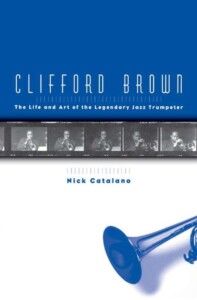Clifford Brown – Complete Transcriptions by Marc Lewis.
Come join us now, and enjoy playing your beloved music and browse through great scores of every level and styles!
Can’t find the songbook you’re looking for? Please, email us at: sheetmusiclibrarypdf@gmail.com We’d like to help you!

Best Sheet Music download from our Library.
Contents List Download:
Please, subscribe to our Library.
If you are already a subscriber, please, check our NEW SCORES’ page every month for new sheet music. THANK YOU!

About Clifford Brown
Trumpeter Clifford Brown (October 30, 1930, Wilmington, Delaware, United States – June 26, 1956, Turnpike, Pennsylvania, United States) was born on October 30, 1930, and by the age of 22 was already a trumpet star, having worked with Tadd Dameron, Art Blakey, and Lionel Hampton.
With the vibraphonist, he even went on a European tour, of which fortunately there are recorded records. At 23, he made his first recordings (particularly significant was the song “Easy Living” for the Blue Note label), and the following year he was already in the group that would bring him fame and prestige in the jazz world: the quintet he formed with drummer Max Roach.
It was 1954, and the quintet the two musicians formed, which lasted until the trumpeter’s tragic death in a car accident on June 28, 1964, was one of the essential pillars of hard bop, a style that emerged as a result of the recapitulation of bebop and the need to recover the roots of jazz, somewhat affected by certain white instrumentalists wrapped in the formula of cool on the West Coast of the United States. The impression this quintet made was extraordinarily positive. The first recordings for the Emarcy label were made on August 2, 1954, and the last on February 17, 1956.
What did Clifford Brown contribute to jazz? Building on the formal conciseness that Fats Navarro had applied to bebop, Clifford freed his music from the constraints of meter, introduced volume variability, and resolved the problem of thematics by recovering the “story to be told” as the basis of the solo, an element largely lost in the abstractions of bebop. He created an open, sensual, and virile sound, more appropriate for a tenor sax than a trumpet, and helped reestablish the figure of the soloist-composer, which became very important from then on, and, crucially, with an exquisitely trumpet-like sound. After Clifford’s premature and tragic death—he was barely 26 years old—his albums are included among the best hard bop records.

Browse in the Library:
Or browse in the categories menus & download the Library Catalog PDF:
Clifford Brown Discography
DiscographyAs leader/co-leader
1953: New Faces, New Sounds with Lou Donaldson (Blue Note, 1953)[10 inch]
1953: New Star on the Horizon (Blue Note, 1953)[10 inch]
1953: A Study In Dameronia (Prestige, 1955)[10 inch]
1953: Clifford Brown and Art Farmer with The Swedish All Stars with Art Farmer (Prestige, 1954)[10 inch]
1954: Clifford Brown & Max Roach (EmArcy, 1954)[10 inch]
1954: Brown and Roach Incorporated (EmArcy, 1955)
1954: Clifford Brown All Stars (EmArcy, 1956)
1954: Best Coast Jazz (EmArcy, 1956)
1954: Jam Session with Clark Terry and Maynard Ferguson (EmArcy, 1954) – live
1955: Clifford Brown with Strings (EmArcy, 1955)
1955: Study in Brown (EmArcy, 1955)
1956: Clifford Brown and Max Roach at Basin Street (EmArcy, 1956)